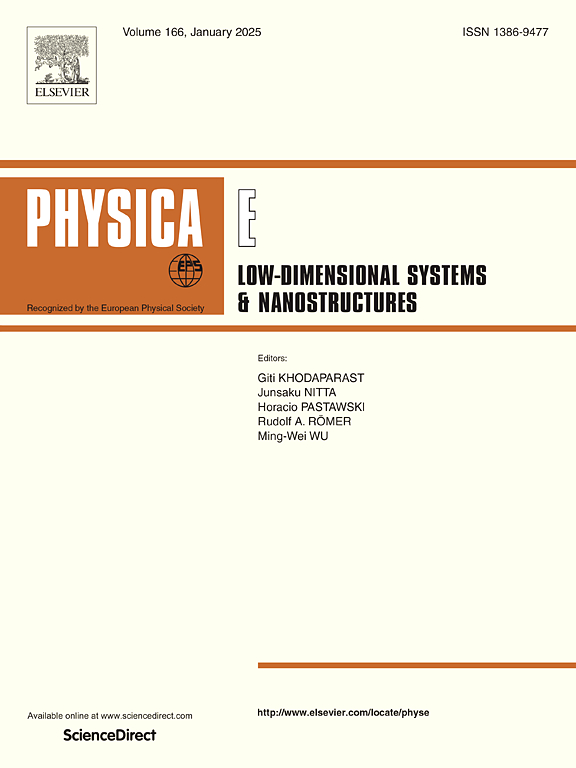Structure, energetics, and dynamics of penta-graphene nanoscrolls
IF 2.9
3区 物理与天体物理
Q3 NANOSCIENCE & NANOTECHNOLOGY
Physica E-low-dimensional Systems & Nanostructures
Pub Date : 2025-07-04
DOI:10.1016/j.physe.2025.116321
引用次数: 0
Abstract
Nanoscrolls can be derived from two-dimensional materials by rolling them into a papyrus-like structure. Their open-ended geometry gives them unique properties, such as variable interlayer distances. Nanoscrolls based on various types of monolayers have been proposed in the last decades, and in this work, we employ reactive Molecular Dynamics simulations to investigate penta-graphene nanoscrolls (PGNSs). We also study graphene nanoscrolls (GNSs) for comparison. Our energy analysis reveals that both scroll types are stable. We observed substantial differences when comparing the dynamics of GNSs and PGNSs, with the number of turns increasing to raise van der Waals interactions in the former. In contrast, this number always remained constant in the latter. Our results show that this difference arises from the different frictional characteristics of the parent monolayers, as the presence of buckling in penta-graphene leads to high friction, preventing edge movement in PGNSs. Our study highlights the importance of the frictional characteristics of monolayers to the dynamics of nanoscrolls.

五石墨烯纳米卷的结构、能量学和动力学
通过将二维材料卷成类似纸莎草纸的结构,可以得到纳米卷。它们的开放式几何结构赋予了它们独特的属性,比如可变的层间距离。在过去的几十年里,人们提出了基于各种类型单层的纳米卷,在这项工作中,我们采用反应分子动力学模拟来研究五石墨烯纳米卷(PGNSs)。我们还研究了石墨烯纳米卷(GNSs)进行比较。我们的能量分析表明,两种涡旋类型都是稳定的。在比较GNSs和PGNSs的动态时,我们观察到实质性的差异,前者的轮数增加以提高范德华相互作用。相比之下,后者的这个数字总是保持不变。我们的研究结果表明,这种差异源于母层单层的不同摩擦特性,因为五石墨烯中的屈曲导致高摩擦,从而阻止了PGNSs中的边缘运动。我们的研究强调了单层膜的摩擦特性对纳米涡旋动力学的重要性。
本文章由计算机程序翻译,如有差异,请以英文原文为准。
求助全文
约1分钟内获得全文
求助全文
来源期刊
CiteScore
7.30
自引率
6.10%
发文量
356
审稿时长
65 days
期刊介绍:
Physica E: Low-dimensional systems and nanostructures contains papers and invited review articles on the fundamental and applied aspects of physics in low-dimensional electron systems, in semiconductor heterostructures, oxide interfaces, quantum wells and superlattices, quantum wires and dots, novel quantum states of matter such as topological insulators, and Weyl semimetals.
Both theoretical and experimental contributions are invited. Topics suitable for publication in this journal include spin related phenomena, optical and transport properties, many-body effects, integer and fractional quantum Hall effects, quantum spin Hall effect, single electron effects and devices, Majorana fermions, and other novel phenomena.
Keywords:
• topological insulators/superconductors, majorana fermions, Wyel semimetals;
• quantum and neuromorphic computing/quantum information physics and devices based on low dimensional systems;
• layered superconductivity, low dimensional systems with superconducting proximity effect;
• 2D materials such as transition metal dichalcogenides;
• oxide heterostructures including ZnO, SrTiO3 etc;
• carbon nanostructures (graphene, carbon nanotubes, diamond NV center, etc.)
• quantum wells and superlattices;
• quantum Hall effect, quantum spin Hall effect, quantum anomalous Hall effect;
• optical- and phonons-related phenomena;
• magnetic-semiconductor structures;
• charge/spin-, magnon-, skyrmion-, Cooper pair- and majorana fermion- transport and tunneling;
• ultra-fast nonlinear optical phenomena;
• novel devices and applications (such as high performance sensor, solar cell, etc);
• novel growth and fabrication techniques for nanostructures

 求助内容:
求助内容: 应助结果提醒方式:
应助结果提醒方式:


